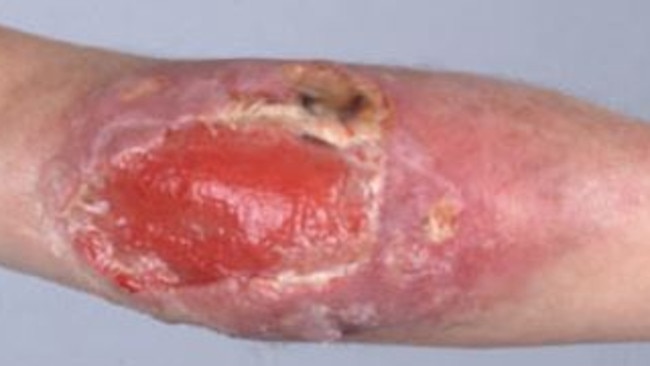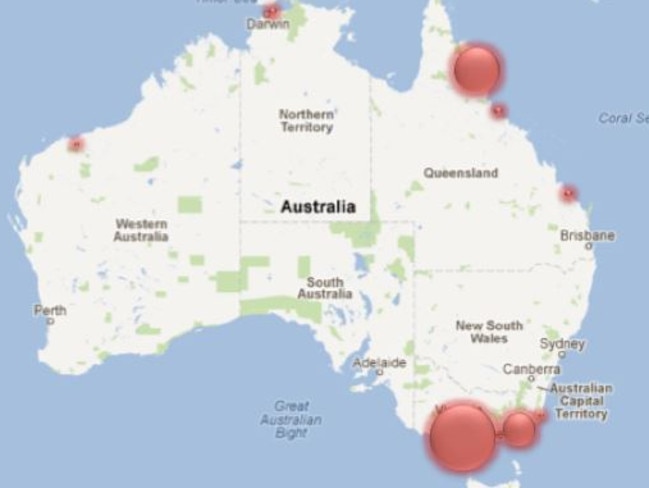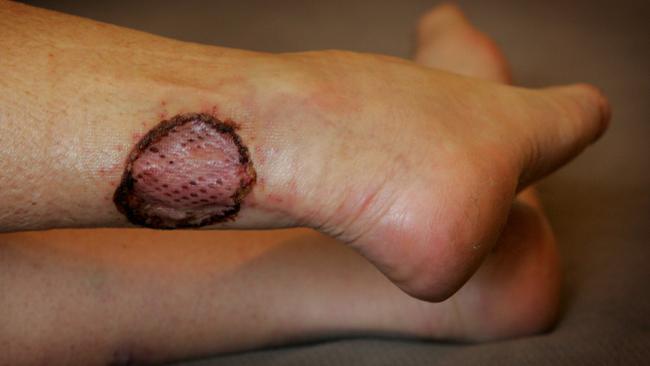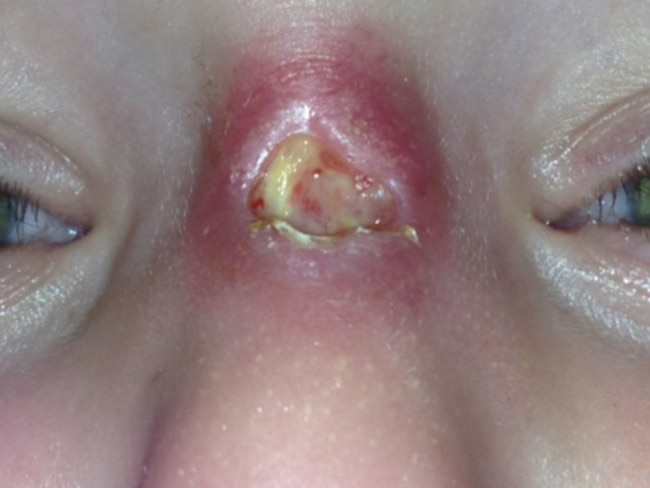Bairnsdale Ulcer could spread to other Australian states
A FLESH-eating zombie bug is spreading here, gnawing away skin and causing amputations in extreme cases. WARNING: Graphic.

WARNING: Graphic images
A FLESH-eating zombie bug is spreading in Australia, gnawing at skin and causing amputations in extreme cases.
The Bairnsdale ulcer has been around for decades but its prevalence in the country is growing, with parts of Victoria and Queensland becoming hot spots.
And NSW could be next.
Tens of thousands of people are at risk of catching the gruesome flesh-eating bug, and doctors aren’t sure where it comes from or what causes it.
It is believed the bug is spread by either mosquitoes, or through possums after they have been bitten by the insect.
It starts out looking like any normal mosquito bite but months later a volcano-like wound will develop and start eating through the flesh.
It’s easily curable if caught early but, if not, it can lead to further complications. Some sufferers need surgery, some endure extreme scarring and others even need to have limbs amputated.
The bug is aggressive and ulcer can be transmitted to a person as soon as they step into one of the hot spots.
Earlier this month, it was reported the bug had spread to the Melbourne suburbs of Bentleigh, Hampton and Cheltenham, southeast of the CBD.

Austin Health infectious diseases physician and medical researcher Professor Paul Johnson said the bug should not be ignored.
He said more research needed to be done into the spread of the disease, to stop it seeping into other states.
Prof Johnson said there was a Bairnsdale ulcer outbreak in the Mornington and Bellarine peninsulas in recent decades but it had since spread to Frankston, an outer-southeastern suburb of Melbourne, and even some southern parts of NSW.
Prof Johnson said he couldn’t understand why it was not there already, considering parts of the state had the same climate as suburbs in Melbourne that were hot spots for the flesh-eating bug.
“There’s been some cases near the Victorian border and it could creep up from there,” he said.
Prof Johnson said the Bairnsdale ulcer was very unpredictable and quickly changed its path, much like migrating birds.
“In Victoria it moved progressively west but stopped at Torquay. Now it’s moving back to the east,” he said.

Prof Johnson believed mosquitoes were carrying the bug and transmitting it to people through their bites.
“We still don’t know a lot about where it’s coming from,” he said.
“One current theory is maybe it’s spreading in possums and somehow humans get infections indirectly. Maybe they are getting it from possums via mosquitoes. But maybe possums are just victims of it, like humans.”
The Bairnsdale ulcer, also known at the Buruli ulcer, can also affect bones if it worsens.
Prof Johnson said in rare cases the ulcer could also cause gangrene, the death and decomposition of body tissue.
There have been cases in other countries, predominantly in Nigeria, Mali and other west African countries.
Australia is the only developed country with significant Bairnsdale ulcer outbreaks.


The number of cases has almost doubled in the past three years. In 2015, there were 106 cases recorded in Victoria, up from the 65 in 2013.
There have already been 45 cases recorded this year in Victoria alone.
In a health warning from Victoria Health this month, chief health officer Professor Charles Guest said the bug remained a “concern” in the state.
“Everyone is susceptible to infection,” the warning states.
“Although the source of the infection is unknown, this environmental organism appears to be associated with swampy or stagnant water, and/or coastal vegetation.”
There has also been a number of people infected by the flesh-eating bug in far-north Queensland near Mossman and on the Capricorn Coast of Queensland near Yeppoon.
The tropical north coast near Darwin has also suffered an outbreak.
Prof Johnson said last year there were only about three cases in Queensland but the state suffered from a massive outbreak in 2011.
“Queensland may have none of very few cases but every now and then there will be an outbreak, likely occurring in the Mossman area,” Prof Johnson said.

He said it mainly affected healthy people from the very young to the old.
“It’s not a disease of the sick and weak,” Prof Johnson said.
The Bairnsdale ulcer often erupts on the elbow, back, calf or ankle about four months after a person has been bitten.
The incubation process is slow, and it’s likely transmitted while people are in tropical and coastal climates.
“We still don’t understand why people get it and exactly how to stop it, and how to stop it moving around,” Prof Johnson said.
“It starts as something strange and innocuous but it gradually gets bigger and looks like a small volcano on your skin.
“It gradually swells and hollows out and discharges.”

Holidaymakers have been among those who have found the Bairnsdale ulcer lurking beneath their skin and, last year, two-year-old toddler Sonny Hayes-Marshall was the second youngest victim to ever suffer from the disease.
The Geelong Advertiser reported his nose was infested with the flesh-eating bug and there were fears he would lose his eyesight.
“My main concern was this bug going near his eyes because it just literally kills and eats away at the flesh,” mother Laura Hayes told Geelong Advertiser.
The bug eats through healthy cells, gnawing through skin, nerve, blood and fat cells.
Ms Hayes said it was just a little red dot that you could hardly notice.
“It was like the size of a pin head at first but it just kept getting bigger,” she said.
Prof Johnson said doctors in NSW were yet to deal with many Bairnsdale ulcer cases and encouraged anybody concerned to talk to their health professional.
The chief health officer of Victoria said the bug was first diagnosed in the Bairnsdale area in the 1930s and, since 2012, areas on the Mornington Peninsula, particularly Rye and surrounding townships, had seen a growing number of cases.
Professor Guest said wearing appropriate, protective clothing when gardening and undertaking recreational activities in areas with the Bairnsdale ulcer would prevent infection.
Cuts and abrasions should also be cleaned promptly and exposed skin contaminated by suspect soil or water should be washed following outdoor activities.
Professor Guest said people should also protect themselves with insect repellent.




